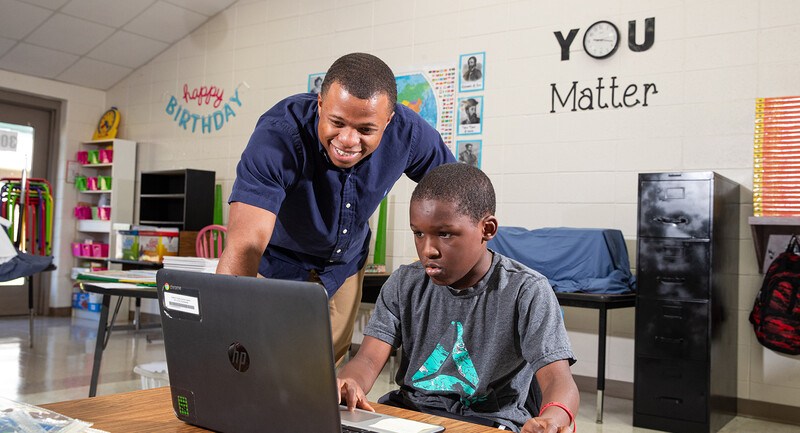We educators love a good motivational quote. Posters with pithy sayings pepper our hallways and classrooms. Michael Jordan reminds us how many shots he missed. Nelson Mandela reminds us to rise no matter how often we fall. And Albert Einstein reminds us all sorts of (often misattributed) things about our mind's potential.
Our love of inspirational mottos stems from a desire to build efficacy—a person's belief in their ability to accomplish goals. And there are many reasons we should care to build efficacy. One, higher levels of teacher efficacy yield higher levels of student efficacy (Ross et al., 2001). Two, high teacher self-efficacy is linked to increased job satisfaction, lower emotional exhaustion, and lower burnout (Skaalvik & Skaalvik, 2014).
Words are surely a powerful way to cultivate efficacy: Verbal persuasion—what others say to or about us—is one of four major sources of efficacy (Bandura, 1977). The other three are physical and affective states (feeling pleasant or unpleasant physically and emotionally); social modeling (learning from others' failures or successes); and mastery experience (succeeding at difficult goals in the face of challenges).
So, it would make sense that "conquer the day" quotes surround us at every classroom corner; verbal persuasion can put us in a positive affective state. Plus, a social role model, like Jordan, inspires us.
There's only one problem—and it's a big one: The most important source of efficacy is mastery experience (Bandura, 1977). The other three sources are most effective only when they bolster mastery experience. This isn't to say we can't use praise and positive words to help people feel good, but feeling good doesn't always lead to efficacy. Telling a student they are "doing great" as they continue to fail at a task can make them feel deflated. Without leading to mastery experience, persuasion, modeling, and affective states are frills without substance—feeling good without fueling growth.
Michael Jordan isn't a legendary basketball player because he missed a lot of shots (otherwise I'd be in the hall of fame). He's famous because he demonstrated great technique under pressure. Nelson Mandela didn't help end apartheid because he could turn a good phrase but because he organized protests and used his activism, persuasion, and legal skills to negotiate for a new constitution. And no one would remember E=MC2 if Albert Einstein's theory of relativity was bunk. Mastery experiences, not feel-good sayings, are the root of success.
So, if we want to lead through times of change, we must provide the conditioning and coaching that yield mastery experiences for our students and staff. If we want them to be efficacious, we must plan for mastery.
The Efficacy Ladder
The most powerful model I've used to ensure mastery experience is what I call the Efficacy Ladder (see figure 1). At the top of the ladder is an end goal, like running a marathon or writing an effective essay or implementing whole-school cross-curricular reading. Moving down the rungs of the ladder are progress goals: preceding steps that must be taken. Before I can run 26.2 miles, I should probably be able to run at least 20. Before 20 miles, I should probably be able to run at least 15. And so on. Depending on the top-level goal, there might be many rungs or just a few. The first step of the ladder is an easy goal that can be accomplished quickly (like getting off the couch and running to the end of my block and back).
Figure 1: The Efficacy Ladder
The structure of an Efficacy Ladder prioritizes mastery experience. First, it makes the end goal clear. Second, it breaks the big goal into tangible progress goals—steps that outline the time and actions needed to achieve the mastery experience. Rather than waiting for evidence of mastery (e.g., a summative assessment), we get more immediate and frequent feedback (checkpoints that become "micro wins" to cue positive emotional states, a second root of efficacy).
But we can take it a step further (pun satisfyingly intended): Between each rung, we maximize efficacy-growth by building in social modeling—strategies like exemplars, observing or studying the works of others, or classic "I do, we do, you do" frameworks. Along the entire experience we provide verbal persuasion: frequent, ongoing feedback; affirmation; and praise. We plan for how educators or students will know whether the step they took worked—and we give them guidance if they aren't improving.
Efficacy Ladders create visible, orchestrated success by embedding all roots of efficacy, and they can be used at all levels of a school or organization. Here are some examples of how I've used them in my own practice:
1. Student efficacy: When I taught the writing process, I provided students with an Efficacy Ladder so they could see the steps toward building their final product. We started simply (step one), using discussion and ungraded free writes to prompt idea generation—something every student could succeed at. I had students model their work and thinking between each checkpoint of brainstorming, outlining, drafting, and revising. Plus, I built in mid-draft conferencing in small groups to provide coaching along the way.
2. Educator efficacy: I remember feeling deflated when my first effort to use Socratic Circles, a lofty goal, failed miserably. So, I reworked my plan using the Efficacy Ladder. I specified what the end goal would look like (top of the ladder) and then broke it down. I realized there were more immediate skills I could develop, such as teaching students to build off each other's responses when I called on them and teaching sentence conversation stems. I modeled and provided feedback on these "Socratic micro-skills." Each success built my (and my students') mastery in a methodical way.
Efficacy Ladders create visible, orchestrated success by embedding all roots of efficacy, and they can be used at all levels of a school or organization.
3. Organizational efficacy: Launching new initiatives can be frustrating without efficacy support in place. A school I consulted recently wanted to go all-in on implementing PLCs, as soon as possible. Before launching into the work, though, I sat with school leaders to break down the plan:
How will you know what successful implementation—the end goal—looks like? How will educators know they are successfully implementing it?
What are the logical sub-steps you must master before you move up the ladder of efficacy?
How long will it take to achieve efficacy with each sub-step?
What structures and supports are you building into your plan to ensure regular coaching and feedback?
At the end of our discussion, the team realized they needed to be more realistic, patient, and intentional with their rollout—and they had a plan to do so with well-designed mastery experiences.
Mastery Experience (or Bust)
Words matter. Educators and students need positive models. And motivation is driven by emotional states. But the purpose of motivational pep talks and posters should be to serve mastery experience, not supplant it. Words don't create success. Actions do. Put that on a poster. Better yet, put it into action.









